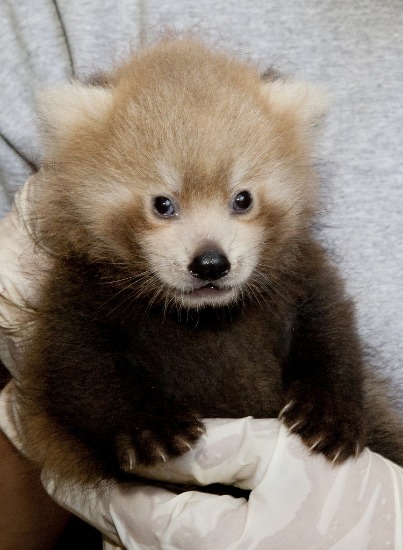Zoo’s Red Panda Cubs Get Their Names
The newest additions to the Zoo’s red panda family are named for the stormy night they were born
/https://tf-cmsv2-smithsonianmag-media.s3.amazonaws.com/filer/20111003025005red-panda-baby-cubs-names.jpg)
On the stormy night of June 17, as thunder and lightning surrounded the National Zoo, two red panda cubs were born. Last week, as part of a voting contest, they received their names. The twin cubs are now known as Pili and Damini, which mean “clap of thunder” in Chinese and “lightning” in Nepalese, respectively. Their births and successful rearing bring the Zoo’s total population of red pandas to five.
“There are about 10,000 red pandas in the wild, but there are only about 2,500 that are breeding, so they are an endangered species,” says Stacey Tabellario, a keeper at the Zoo. Working with the Smithsonian Conservation Biology Institute, where two other red panda cubs were born earlier in the summer, the Zoo has had a breeding program in place for the species for decades.

One of the red panda cubs born at the Smithsonian Conservation Biology Institute. Photo by Mehgan Murphy
“Their name, ‘panda,’ just like the giant panda, actually means bamboo,” Tabellario says. “Their diet is around 80 percent bamboo, and the rest is filled with fruit. They might occasionally catch a bird or eat mushrooms.”
Because the species is native to the mountainous environment of Nepal and China, she says, “They’re very fuzzy, and they don’t bear warm weather well at all. They love the snow, and when they’re out in the snow they actually have fur on their paws so they can walk around on snow and ice without getting cold feet.”
Breeding and caring for the quickly growing cubs has presented new challenges for the Zoo staff. Initially, keepers gave them a wide berth so as not to upset them or their nursing mother, Shama. “After they got a little bit more comfortable with us, we were able to go in, examine them, and get their weight,” says Tallie Wiles, another keeper at the Zoo. “And then when we had the hurricane, we had to move all of them inside into the giant panda enclosure.”
The cubs, now more than four months old and in good health, have recently started venturing out of their den, giving Zoo visitors a great opportunity to see the young animals. “They have just started coming out on exhibit a lot, so the public is getting a great look at them,” Wiles says. Through the Zoo’s red panda webcam, observers can go online to see what the pandas are up to, day or night.
The red panda adults typically breed once annually. “Normally, we see a lot of breeding behaviors. Last year, it was about a week where they were just going crazy—chasing each other, playing, and we saw a lot of breeding attempts,” says Wiles. A cub was born last year, but didn’t survive infancy, which is common for the species.
This year, Zoo staff were less confident that the pandas had successfully conceived, because they saw breeding behaviors from the animals for just one day. The pandas, though, picked the right day to mate. “The one day that we saw breeding happened to be February 14th: Valentine’s day,” Tabellario says.
/https://tf-cmsv2-smithsonianmag-media.s3.amazonaws.com/accounts/headshot/joseph-stromberg-240.jpg)
/https://tf-cmsv2-smithsonianmag-media.s3.amazonaws.com/accounts/headshot/joseph-stromberg-240.jpg)